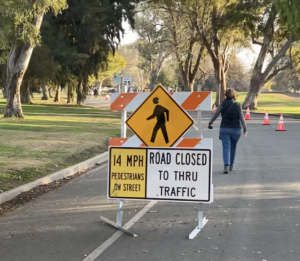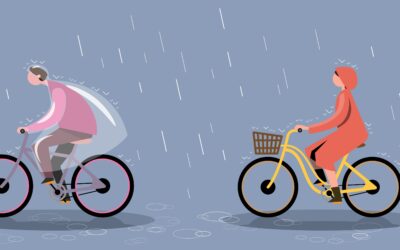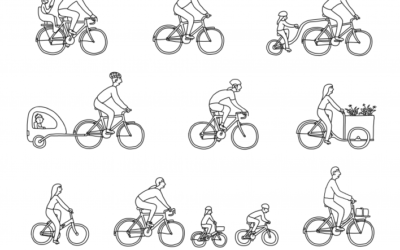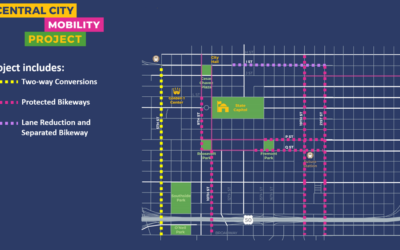Slow and Active Streets
After months of advocating for Slow and Active Streets, on February 12th, the first set of Slow and Active Streets were launched in the Midtown/Newton Booth neighborhoods. YAY!
What is a Slow and Active Street?
- They are residential in nature and a classified as a “local street” (as opposed to collector or arterial streets);
- Have no more than one travel lane in each direction;
- Have a speed limit of no more than 25mph;
- Are not on a bus or light-rail route; and
- Do not have a Police or Fire Station on the street.
They look like this picture from Oakland, which has had close to 75 miles of Slow Streets since May 2020. The street below is now open for people to walk, stroll, skate, scoot, and ride down without fear of cars zooming through. Residents with cars are still able to access the street, but other through-traffic moves to a parallel roadway. Oakland’s Slow Streets effort stemmed from the initial pandemic lockdown. Months later, Oaklanders are happy to have them. They report higher usage of these streets, and more residents are getting outside, riding their bicycles, enjoying the fresh air and space. No doubt, problems remain, but OakDOT is committed to working with communities to make the changes needed. 
SABA has been instrumental in launching the effort in Sacramento with many community partners. Our earliest work on Slow and Active Streets was with WALK Sacramento.
With sustained advocacy from a wide swath of the Sacramento community, in December 2020, City Council and the Mayor said Yes! to a Slow and Active Streets program in Sacramento as a pilot, which is among the first set of recommendations from the Mayors’ Commission on Climate Change. The pilot program is open to all neighborhoods in Sacramento with priority given to Environmental Justice (EJ) neighborhoods. The pilot program is set to run until the end of July 2021.
The pilot has funding for up to 6 miles of Slow and Active Streets. As of now (mid-February 2021), one application has been implemented. Applications have been submitted for the remaining miles of Slow and Active Streets. See this map for the current set of Slow and Active Streets either implemented or proposed for Sacramento (blue = implemented, red = proposed).
Funding has been minimal and with thin City resources (time and dollars), it is not a sure thing that all of the neighborhood groups that want a Slow and Active Street in their neighborhood, will get to experience them. If you live in a neighborhood that has proposed Slow and Active Streets on them, get in touch with your Neighborhood Association to learn more about the pilot. Also the City’s Slow and Active Streets webpage has information on the proposed Slow and Active Street offerings. Communities with proposed Slow and Active Streets will have a chance to provide important feedback to the City. Your input in local survey and informational zoom meetings is crucial to learn how the pilot is running. The more information provided, the better the decision-making will be.
As a pilot project, these streets will need to be evaluated and the city will need to hear from community members.
- What do neighbors think about having a street closed to thru-traffic?
- Have they made life easier during the pandemic?
- Did they make traffic worse on adjacent streets?
- How could they be improved?
- Should they remain closed indefinitely?
Evaluation of effectiveness is key, especially if this pilot informs a larger vision of changing our streets, and making them less car-centric and more people-centric.
SABA encourages everyone to get out and ride, walk, skate or scoot on these streets to have an experience. Some residents are already enjoying the new Slow and Active Streets in Midtown. A group of cyclists from North Natomas cycled over to the Slow and Active Streets on Valentine’s Day. They met new City Council member, Katie Valenzuela! Check this too!
Get out and ride! Experience these Slow and Active Streets, and let us know your thoughts and ideas.
Connecting the Grid

The dense, urban downtown Sacramento Grid is an ideal place for making trips by bike. In fact, the Midtown neighborhood has rates of bicycling equal to parts of Davis.
We strongly support the City of Sacramento’s ongoing efforts to install bike infrastructure that makes biking a convenient, comfortable, safe alternative to driving.
To ensure that the City of Sacramento continues to capitalize on the conditions in the Grid that support bicycling, we’re focused on fixing these persistent disconnects:
– Along the south and east edges, at the ramps leading to and from the Capitol City Freeway.

– North of P Street and west of 16th Street, the area comprising the State Capitol, City Hall, County Administration Building, Golden 1 Center, Central Library, Sacramento Valley Station and the Kaiser Medical Center. This part of the Grid has the highest concentration of public destinations, employment centers and transit hubs, but the fewest streets with bike lanes and other bike-friendly infrastructure.

– North from downtown into the River District, which is served by just three streets, two of them unusable by bikes. Improving access to the Sacramento Northern Bikeway remains a critical need. We recently helped gather substantial community input to demonstrate the demand for much better access for people on bikes on N. 16th Street. Read more here.
Vision Zero
The City of Sacramento’s Vision Zero program aspires to eliminate severe injury and fatal traffic collisions of all types by 2027. In setting this goal, the City of Sacramento has committed to making safety its highest priority in deciding where to implement roadway improvements and other interventions.

As a member of the City’s Vision Zero Action Team, we strongly believe that mobility must be an equal priority for the Vision Zero program. We work with neighborhood groups and others to ensure that the City’s actions to implement Vision Zero are thoughtful, balanced and equitable. Read more here.
Multi-use trails
One of our region’s most valuable recreational assets is a network of off-street, paved trails for biking and walking, including the Jedediah Smith Memorial Trail along the American River.
Multi-use trails enable people to enjoy healthy activity without driving and introduce children to the joys of riding a bike. They also serve as comfortable, convenient routes for everyday travel by bike.

We’re currently actively advocating for seven trails and trail projects in our region: Two Rivers Trail, Sacramento Northern Bikeway, Sacramento River Parkway and Del Rio Trail in Sacramento, Sycamore Trail in West Sacramento, Cordova Creek Trail in Rancho Cordova and Dry Creek Greenway in Roseville.
Best practices
The Sacramento region has enormous potential as a place where bicycling is a convenient, comfortable, clean form of everyday travel. To help realize that potential, we advocate for best practices in planning, engineering, funding, programs and laws that prioritize active transportation.
Through Sacramento’s Bicycle Advisory Committee, we got the City of Sacramento to add explicit goals for connectivity, equity, safety and ridership when it updated its Bicycle Master Plan in 2016. As other jurisdictions update their bicycle master plans, we’ll work to ensure that they reflect modern best practices for meeting these goals. The City of Roseville plans to begin updating its bicycle master plan. Sacramento County’s Bikeway Master Plan was last updated in 2011, well before the adoption of federal and state standards for protected bikeways and other modern bicycle infrastructure.
A few years back, we led a coalition campaign for crucial safety improvements on Carlson Drive near the Sac State University campus in East Sacramento. Lately we have been working closely with groups supporting the Freeport Blvd. bike improvements in Sacramento’s Land Park neighborhood.
Stakeholder role
 We’re routinely invited to participate as a stakeholder in the early stages of major proposed projects. We represent people on bikes in forums organized by public agencies to help shape such major long-term projects as the Green Line to the Airport and Plan Folsom Blvd., and have an ongoing role in the implementation of bike share in our region. Plus, we represent people on bikes on advisory committees and working groups such as the SACOG Bicycle-Pedestrian Advisory Committee and Sacramento State University Bicycle Task Force. For more information see our Project Review page.
We’re routinely invited to participate as a stakeholder in the early stages of major proposed projects. We represent people on bikes in forums organized by public agencies to help shape such major long-term projects as the Green Line to the Airport and Plan Folsom Blvd., and have an ongoing role in the implementation of bike share in our region. Plus, we represent people on bikes on advisory committees and working groups such as the SACOG Bicycle-Pedestrian Advisory Committee and Sacramento State University Bicycle Task Force. For more information see our Project Review page.








